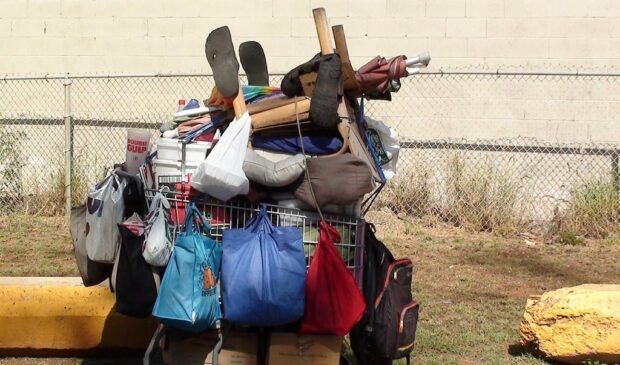Homelessness strategy plan calls for $101M in spending from city, partner groups
Tuesday, April 29, 2025 by
Chad Swiatecki Austin’s Homeless Strategy Office is proposing a funding package totaling just under $101 million for homelessness response efforts in the city’s next budget, with about one-third allocated toward maintaining existing programs, one-third for new city investments, and one-third for initiatives expected to be funded by partner organizations.
The spending plan laid out in a presentation to a joint meeting of the City Council’s Audit and Finance Committee and Public Health Committee includes approximately $15.65 million to continue support for programs currently funded by soon-to-expire American Rescue Plan Act dollars, $7.3 million in other existing one-time initiatives that would need ongoing support, and roughly $33 million in new investments to expand services and shelter capacity. Additional contributions from outside funders totaling about $16.2 million are also being sought.
The proposed investments broadly break down as follows:
- Roughly $3.8 million for prevention, diversion, and rapid-exit services to keep people housed or quickly rehouse them
- About $5 million for expanded street outreach and encampment management efforts
- Approximately $32.3 million plus capital costs to expand emergency shelter capacity, with a goal to add 550 new shelter beds by 2029
- Nearly $24 million for rapid rehousing programs that connect people to short-term rental assistance and case management
- Around $8 million for ongoing supportive services tied to permanent supportive housing projects already underway
- An anticipated $23 million per year in new spending after 2027 to continue growing the city’s permanent supportive housing inventory through 2034
The presentation emphasized that maintaining the city’s homelessness response at current service levels would require about $22.9 million in addition to new funds to replace expiring federal dollars. City budget officials confirmed that closing that gap on top of addressing a projected $33 million budget shortfall would likely require seeking additional tax revenue through a voter-approved tax rate election that could take place later this year.
David Gray, director of the city’s Homeless Strategy Office, said that if the city and its partners can secure the proposed funding, the community should expect “a measurable reduction in the prevalence of homelessness,” with faster response times to service requests, shorter shelter waitlists, and more positive housing outcomes for shelter and outreach clients.
“Our system is successful. When people leave our system, when they exit homelessness in Austin, the majority of those folks will remain housed, they will not touch our system again,” he said. “That being said, our system is just too small. It’s like a 15-passenger aircraft trying to support 500 people. So we need to add more seats to the plane, and that’s where the additional investment consideration from the city is being set forth.”
Gray also outlined a series of planned and launched initiatives that are aimed at strengthening Austin’s homelessness response system. Among the efforts already underway is a new partnership with Housing Connector, which has helped secure more than 2,300 housing units for at-risk and formerly homeless individuals.
Participating landlords have agreed to lower screening barriers for people who might otherwise be excluded because of criminal histories or other challenges. HSO is also looking at repurposing underutilized city properties for use as engagement hubs or small-capacity micro shelters, typically serving 15 to 20 people per site. While other cities have implemented similar models successfully, Gray said Austin is still working through how best to adapt the approach locally.
To address the lack a network of homeless navigation centers, with Sunrise Navigation Center in South Austin serving as the only full-service facility, Gray said the city and homeless services organizations should establish a more distributed network of navigation centers. While Sunrise has made significant impacts, the location faces challenges because it draws clients from across the city and creates a strain on the surrounding neighborhood.
The city’s investment in shelter capacity has yielded nearly 1,500 beds across the system, but Gray said there is still only one shelter bed for every five unhoused individuals. Efforts already underway include an additional 100 beds being added at Camp Esperanza by The Other Ones Foundation, 50 new medical respite beds being developed by Central Health, and an application jointly submitted with the state that could fund up to 400 additional beds at Camp Esperanza.
Several Council members praised the plan Gray and his team have drafted, which is expected to figure prominently in the city manager’s forthcoming proposed budget. Several noted that the prospect of a tax rate election to substantially increase spending related to homelessness would come with high stakes and expectations from voters.
“Assuming we don’t cut homeless related programs to balance our $33,000,000 deficit, that means we need… about $50 million of new money that we would have to come up for with next year’s budget,” Councilmember Ryan Alter said. “When we’re going to taxpayers, we have to tell them what they’re going to get for that investment. No one’s going to just say, yes. I want to pay more because it feels good. They wanna know, what’s that tangible result? What do they get out of it?”
The Austin Monitor’s work is made possible by donations from the community. Though our reporting covers donors from time to time, we are careful to keep business and editorial efforts separate while maintaining transparency. A complete list of donors is available here, and our code of ethics is explained here.
You're a community leader
And we’re honored you look to us for serious, in-depth news. You know a strong community needs local and dedicated watchdog reporting. We’re here for you and that won’t change. Now will you take the powerful next step and support our nonprofit news organization?



